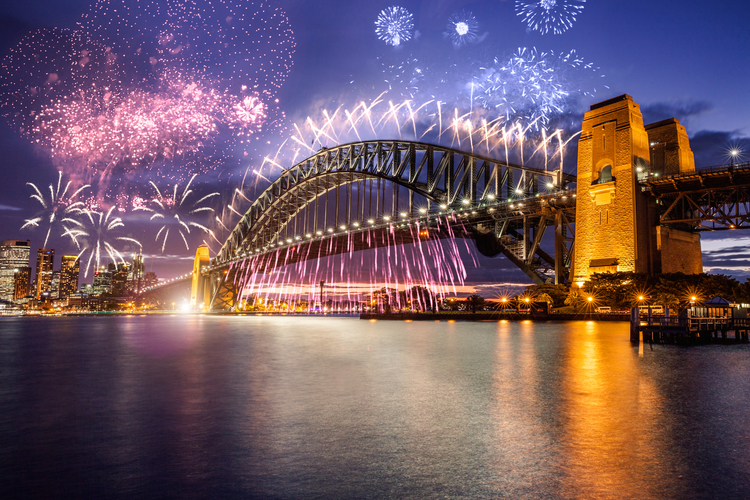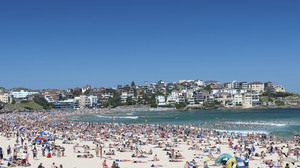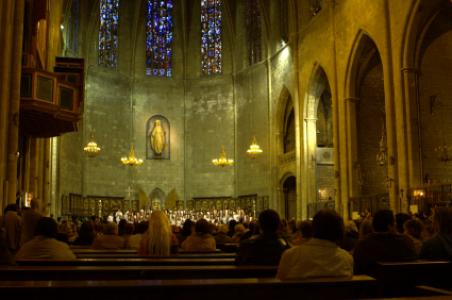
Saturn and Moon Meet in the Sky
Saturn and the Moon will meet up in the night sky for a close approach on November 10–11.
Many Australians annually celebrate New Year’s Eve with parties, music and other forms of entertainment on December 31. New Year’s Eve is the day before New Year’s Day in the Gregorian calendar, which is used by many Australians.

Fireworks over Sydney Harbour Bridge on New Year's Eve.
©iStockphoto.com/LeoPatrizi
Major Australian cities have special New Year’s Eve events that include parades, music and entertainment. Celebrities are often invited as guests of honor or hosts for large New Year’s Eve events. New Year’s Eve balls are popular and have various themes such as masquerade, black-tie and formal wear, tropical, or gangster and glamour. Prizes for most intriguing or best-dressed outfits are awarded at these events. Many people also prepare their New Year’s resolutions for the next day.
Many Australians celebrate New Year’s Eve on boat cruises, urban parklands or beaches. Others hold special parties or barbecues at their own homes. Public countdowns to New Year's Day are made at large events in major cities, such as Sydney, and are often televised so those at home can join in the celebrations. As the clock strikes midnight to mark New Year’s Day, fireworks are launched to farewell the old year and to welcome the new year. People often hug, shake hands or kiss each other on the cheek to show their joy and appreciation for the old and new years. Many people also toast their glasses and drink champagne or wine to commemorate this occasion.
New Year’s Eve is not a public holiday in Australia. However, schools and educational institutions are closed on this day as it is in the school holiday period. Some government offices may be closed or have limited staff as many public servants get time off during this period.
New Year's Eve is the last day of the year and the day before New Year’s Day, which marks the start of a new year according to the Gregorian calendar, which was introduced to Australia by European settlers. Pope Gregory XIII introduced the Gregorian calendar in 1582. It was adopted immediately in some areas of Europe but it was not used in Great Britain until 1752.
It is important to note that not all cultures in Australia follow the Gregorian calendar in observing New Year’s Eve and New Year’s Day. For example the New Year in the Hindu, Chinese, Coptic, Jewish, Islamic calendars differ to that of the Gregorian calendar. Moreover, Australia's financial, or fiscal, year ends on June 30 and the new tax year begins on July 1.
2020 or 2021: When do decades start?
Fireworks symbolize the crossover from New Year’s Eve, which marks the end of the old year, to New Year’s Day, which marks the beginning of the New Year. The largest and most elaborate fireworks occur at midnight between these two days as a way of saying good bye to the past and welcoming the future. The Sydney Harbour is an iconic Australian landmark that is a special symbol of New Year’s Eve celebrations in Australia. On this night, the harbor is lit with spectacular fireworks, where hundreds of cultures unite for the Harbour of Light parade.
| Year | Weekday | Date | Name | Holiday Type | Area |
|---|---|---|---|---|---|
| 2019 | Tue | Dec 31 | New Year's Eve | Part Day Holiday | Northern Territory, South Australia |
| 2019 | Tue | Dec 31 | New Year's Eve | Observance | |
| 2020 | Thu | Dec 31 | New Year's Eve | Part Day Holiday | Northern Territory, South Australia |
| 2020 | Thu | Dec 31 | New Year's Eve | Observance | |
| 2021 | Fri | Dec 31 | New Year's Eve | Observance | |
| 2021 | Fri | Dec 31 | New Year's Eve | Part Day Holiday | Northern Territory, South Australia |
| 2022 | Sat | Dec 31 | New Year's Eve | Observance | |
| 2022 | Sat | Dec 31 | New Year's Eve | Part Day Holiday | Northern Territory, South Australia |
| 2023 | Sun | Dec 31 | New Year's Eve | Part Day Holiday | Northern Territory, South Australia |
| 2023 | Sun | Dec 31 | New Year's Eve | Observance | |
| 2024 | Tue | Dec 31 | New Year's Eve | Part Day Holiday | Northern Territory, South Australia |
| 2024 | Tue | Dec 31 | New Year's Eve | Observance | |
| 2025 | Wed | Dec 31 | New Year's Eve | Part Day Holiday | Northern Territory, South Australia |
| 2025 | Wed | Dec 31 | New Year's Eve | Observance | |
| 2026 | Thu | Dec 31 | New Year's Eve | Observance | |
| 2026 | Thu | Dec 31 | New Year's Eve | Part Day Holiday | Northern Territory, South Australia |
| 2027 | Fri | Dec 31 | New Year's Eve | Observance | |
| 2027 | Fri | Dec 31 | New Year's Eve | Part Day Holiday | Northern Territory, South Australia |
| 2028 | Sun | Dec 31 | New Year's Eve | Part Day Holiday | Northern Territory, South Australia |
| 2028 | Sun | Dec 31 | New Year's Eve | Observance | |
| 2029 | Mon | Dec 31 | New Year's Eve | Observance | |
| 2029 | Mon | Dec 31 | New Year's Eve | Part Day Holiday | Northern Territory, South Australia |
While we diligently research and update our holiday dates, some of the information in the table above may be preliminary. If you find an error, please let us know.

Saturn and the Moon will meet up in the night sky for a close approach on November 10–11.

Your astronomical bucket list—the biggest sky and space highlights of the next half-century you can see with your own eyes.

New Year's Day is the first day of the year in the Gregorian calendar used in Australia and many other countries.

All Souls’ Day is observed among some Christians in Australia on November 2 each year.